New Comet SWAN brightens, while Comet ATLAS continues to fragment and Comet PanSTARRS holds steady.
There's a lot happening in the northern sky these days, namely lots of comets! Comet ATLAS (C/2019 Y4) is still worth watching, but look for the new Comet SWAN (C/2020 F8) and Comet ATLAS (C/2019 Y1). And you can still catch a glimpse of our old friend, Comet PanSTARRS (C/2017 T2) .
Comet Crazy
Comet ATLAS (C/2019 Y4) continues to shed fragments while slowly fading and becoming more diffuse. But it ain't dead yet!
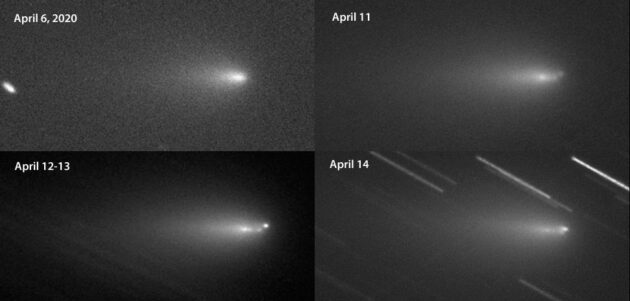
Gianluca Masi and Nick Haigh
Observers are still spotting the crumbling object in 100-mm binoculars and (dimly) in 6-inch telescopes under dark skies. On April 14th at 3h UT the comet's overall magnitude had faded to 9.4, but striking changes have occurred within the inner coma. The nuclear region is now clearly elongated east-to-west with hints of fuzzy condensations visible along its length, using magnifications upward of 300× and averted vision.
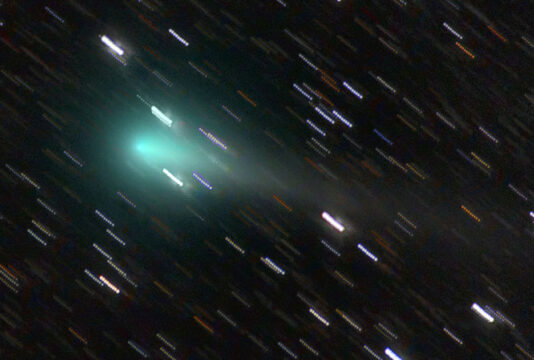
On two recent evenings I was able to momentarily catch sight of the brightest fragment (pictured above) along with one or two additional fuzzy stellarings, faint starlike objects that appear on a nebulous object, in my 15-inch Dob at 400×. I encourage observers with larger telescopes to seek these amazing nuggets out. How often do we get the opportunity to see a comet come apart?
The coma measured 4′ across on April 14 at 3h UT, but when I added a Swan filter, which enhances emissions from gassy comets, Comet ATLAS brightened relative to the background sky and the coma expanded to 5′. Although I spotted the comet faintly in 10×50 binoculars on April 1oth, it was invisible on April 13th. This chart (black-and-white PDF here) is still good for locating ATLAS through late April. Assuming the comet soldiers on I'll update the chart next week.
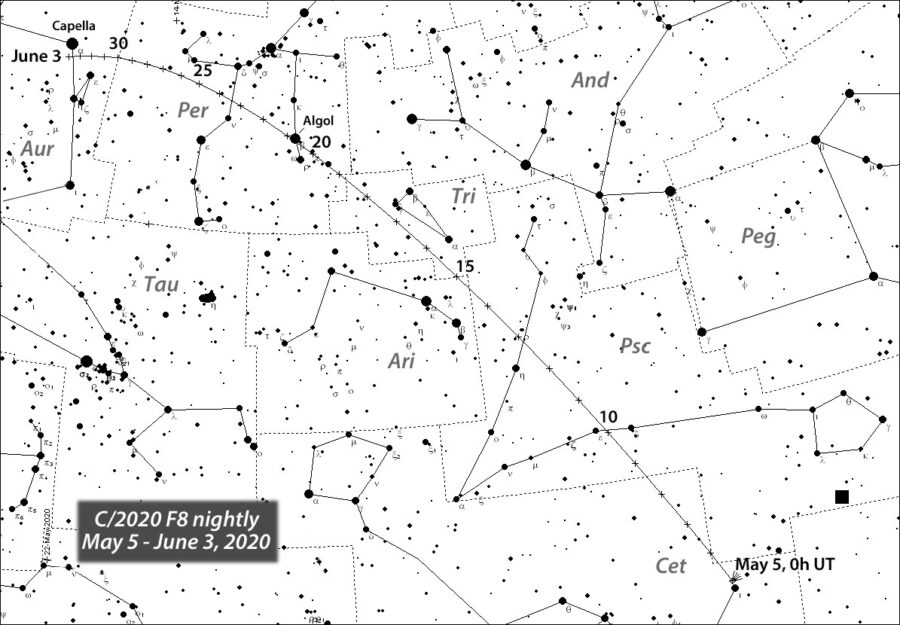
SkyMap software
New Comet to the Rescue
Meanwhile, Michael Mattiazzo of Australia has found a new comet named Comet SWAN (C/2020 F8) in imagery taken by the Solar Wind ANisotropies (SWAN) camera on the Solar and Heliospheric Observatory (SOHO) and publicly available here.
Comet SWAN is presently 8th magnitude, compact, and brightening steadily as it plows across Piscis Austrinus at dawn for Southern Hemisphere observers. Soon it will swing northward, making its first appearance in Aquarius at 7th magnitude for southern U.S. observers by month's end.
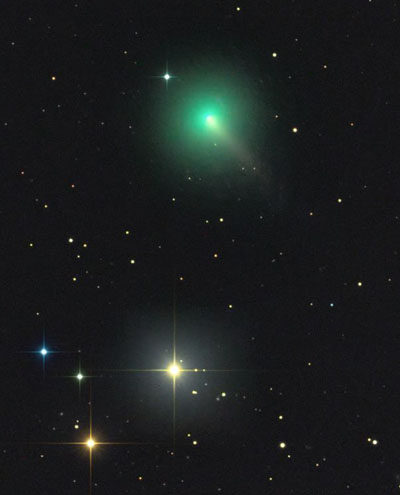
Rolando Ligustri
Comet SWAN (C/2020 F8) will continue to brighten and move rapidly northward in the May dawn sky reaching a peak magnitude of 3.5 between May 15–23 while racing from Triangulum across Perseus. Though bright, the comet remains low in the northeastern sky at the start of dawn throughout the best part of its apparition. Amazingly, Comet SWAN arrived just in time to pinch-hit for ATLAS in the event that comet disintegrates completely. It even reaches peak brightness in the same area of the sky. Perihelion occurs on May 27th at a distance of 64.3 million kilometers.
Comet PanSTARRS Holds Steady
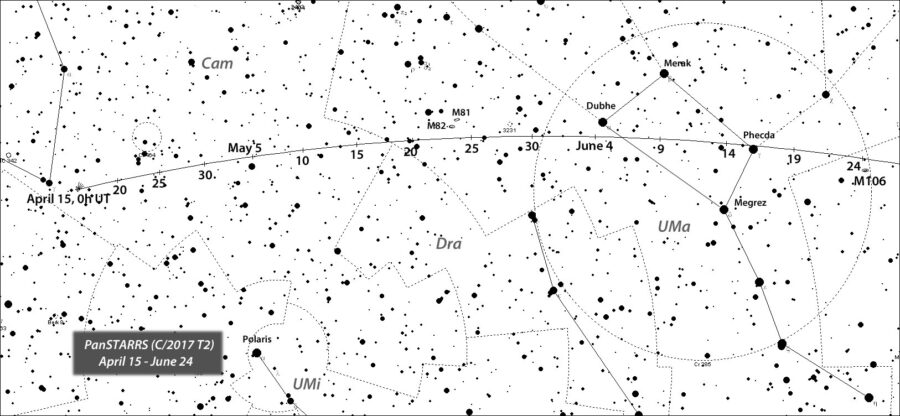
SkyMap
Our final comet, a steady and reliable performer thus far, has taken a back seat in light of all the excitement about naked-eye and disintegrating comets — Comet PanSTARRS (C/2017 T2). It's doing just fine, thank you, as it plies a path across Camelopardalis toward the Big Dipper. From dark skies it's relatively easy to see in 10×50 binoculars at magnitude 8.5. Through my 15-inch on April 11th at 2h UT at 64× I saw a strongly condensed 3.5′ coma with a broad 9′ tail pointing southeast.
Another ATLAS Comet?
... and that's not all. A second ATLAS comet has shown remarkable staying power. Discovered on December 16, 2019, Comet ATLAS (C/2019 Y1) began life as an 18th magnitude blip. It gradually brightened to around magnitude 9.5 by early March while crossing the Great Square of Pegasus low in the western sky at dusk. Perihelion occurred on March 15th.
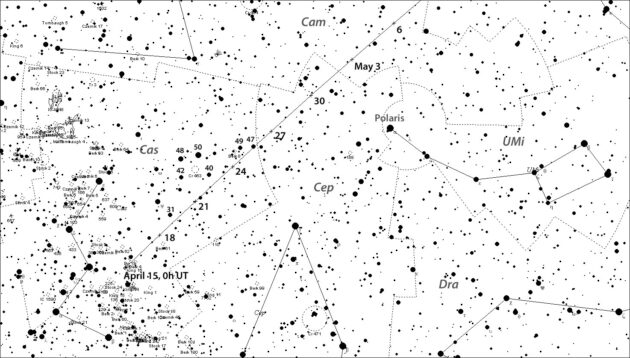
Although expected to fade this month, ATLAS Y1 has remained stubbornly bright. I was frankly surprised when I turned my 15-inch scope toward the comet on April 16.12 UT. At 64x it displayed a strongly condensed, 3′ pale green coma and a faint, north-pointing tail. I had no trouble spotting it in 10x50 binoculars.
Like Comet PanSTARRS and Comet ATLAS Y4, Y1 is a circumpolar object and visible all night long from mid-northern latitudes. Expect the comet to slowly fade as it travels from Cassiopeia through Ursa Minor — passing 6.5° above Polaris on the night of May 1 — and onward to the Big Dipper. Closest approach to Earth at 1.1 a.u. occurs on May 3rd.
So much is happening in the sky right now. Grab your scope and hop on a comet (or four!) the next clear night.
 25
25









Comments
Zubenelgenubi 61
April 15, 2020 at 5:15 pm
Not to be a pessimist, but I would think that SWAN must be intrinsically quite dim to not have been discovered until now. I have not seen any Bortle limit calculations yet, but I wonder if It will make it to perihelion, and even if it does, if the outburst ends, there may not be much to see.
T2 is actually intrinsically much larger than the other two, but won't get close enough to become bright. Comets are frustrating critters sometimes.
You must be logged in to post a comment.
Zubenelgenubi 61
April 15, 2020 at 5:50 pm
Meaning to say that SWAN must have been discovered now due to being in outburst. This is probably not its real level of brightness.
You must be logged in to post a comment.
Bob KingPost Author
April 15, 2020 at 7:59 pm
Zuben,
That's always possible. It may only be in outburst. We shall see. But the magnitude prediction comes from none other than Dan Green and the most recent IAU Circular.
You must be logged in to post a comment.
Douglas-Jackson
April 17, 2020 at 9:53 pm
It doesn't surprise me Comet Swan was missed in the first half of 2020 from NZ and Aussi (I can't speak for SA, Antarctica, etc.) We have had few clear nights and transparency, with dust and smoke from Australian fires overhead, has been average at best. The growing disruption and distraction of the Covid-19 pandemic has probably sidelined many amateurs, and in the Lockdown often kept them physically from their scopes. None of this is excusable or scientific, but it is true nonetheless. Add to that 2019 had many Kiwi stargazers thinking comets were extinct in NZ.Swan may well have flared and choke in coming weeks, but at least it's there, and I'll be watching.
You must be logged in to post a comment.
Bob KingPost Author
April 18, 2020 at 4:13 pm
Thanks for your note, Douglas. We would all appreciate hearing about your Comet SWAN observations as it heads north. I hadn't thought of the virus sidelining amateurs but in certain countries people must stay at home, missing the opportunity to drive to darker skies.
You must be logged in to post a comment.
Alain Maury
April 16, 2020 at 6:03 pm
SWAN is one of the instruments abord the SOHO spacecraft, meaning the comet was discovered when it was in the direction of the sun, therefore not observable by night time surveys.
You must be logged in to post a comment.
Zubenelgenubi 61
April 17, 2020 at 4:47 pm
Comet SWAN is comfortably visible in the morning sky from southern latitudes. It should have been picked up weeks or months ago. It is either in an outburst which will likely subside, or has suddenly "switched on", which would be unusual but not impossible. In the latter case, it could put on a pretty good show, but I doubt it.
You must be logged in to post a comment.
Fabrice Morat
April 15, 2020 at 6:27 pm
Hello Bob,
About the fragmented Atlas comet, I think you are probably right about the the positive response of the comet band filter these days. All photographies like Chris Chur's one show a beautiful aquamarine colour, so this type of filter should enhance its coma. It was the case for me before the fragmentation. So, i don't understand why i didn't detect the same enhancement at last full moon. I need to try it again. Fabrice M.
You must be logged in to post a comment.
Bob KingPost Author
April 15, 2020 at 8:00 pm
Hi Fabrice,
Maybe the full moon overwhelmed the filter's abilities? Try it again and let us know. It worked well for me a few nights ago. Good luck, my friend!
You must be logged in to post a comment.
Fabrice Morat
April 22, 2020 at 6:49 pm
Hello, sorry for the sub topic : Comet Band response for comet Atlas Y4. Bob, i've tried recently without moon glow and i can see a difference relative to the used power. At faint power (100-150x) with the 600mm, the effect of the filter is positive (coma enhanced) but at 300x (not so big yet !), i can judge as a drawn match. It remembers the effect of OIII filter on bright planetary nebulae : at big power, the view often doesn't need filtration... Fabrice M.
You must be logged in to post a comment.
Nursevictoria
April 16, 2020 at 12:12 am
Do u guys think this was a comet? I took this picture on May,22nd 2018 at exactly 5.22am. The clouds were so dense that day, the sun didn’t even break through. I’ve been trying to find out what was in the sky that morning but no luck.
https://scontent-lax3-1.xx.fbcdn.net/v/t1.0-9/fr/cp0/e15/q65/33125674_10214424010487152_3501123121971200000_o.jpg?_nc_cat=109&_nc_sid=110474&efg=eyJpIjoidCJ9&_nc_oc=AQmXt9q1zop0nXqMN_8jWSaItBuRvgIrd4jvp_tbNdiEyH-U4MVW5DtVAl55vFJSSO8&_nc_ht=scontent-lax3-1.xx&_nc_tp=14&oh=ec3684970b840f926b64e43d0f151b28&oe=5EBEB18F
You must be logged in to post a comment.
Bob KingPost Author
April 16, 2020 at 10:54 am
Nurse,
Sorry but this is not a comet. Wish it were. There were no comets that bright around the date the photo was taken. It also looks too cloudy and bright. My guess is that you photographed a small break in the cloud cover.
You must be logged in to post a comment.
Nursevictoria
April 16, 2020 at 4:18 pm
Your probably right, thank you Bob! It got me thinking because sunrise was at 5.46am that day and that light was way above the mountain range in the sky!
Thank you, I can put it to rest now 🙂
You must be logged in to post a comment.
Bob KingPost Author
April 17, 2020 at 3:28 pm
Nurse,
You're welcome. Keep looking up!
You must be logged in to post a comment.
Tom Hoffelder
April 17, 2020 at 6:53 pm
Hello Bob, I am happy to report that I did see the three comets on the evening of the 15th, between 8:45 and 9:10 PM. Even better, about two hours later, I was able to view the supernova in NGC 4277. However, as far as the new SWAN, a "bright" comet at only 5 deg altitude at the beginning of astronomical twilight doesn't seem nearly as much fun as one 50 degrees high at the end of astronomical twilight, as Y4 will be, but no longer bright. As the song says, you can't always get what you want, but you might get what you need.
You must be logged in to post a comment.
Tom Hoffelder
April 17, 2020 at 11:42 pm
Oops, never mind! I was looking at altitudes for Y4 this month, not next month when it was going to be naked eye, and it won't be any higher than SWAN.
You must be logged in to post a comment.
Bob KingPost Author
April 18, 2020 at 4:16 pm
Hi Tom,
Hey, I've been watching that supernova, too! Such a tiny galaxy — it's nearly overwhelmed by the "new" star. If you saw three comets then you must have been pleasantly surprised by ATLAS Y1 which has been performing well — some estimates now put it at mag. 7.4. I estimated 8 last night (April 17).
You must be logged in to post a comment.
Tom Hoffelder
April 19, 2020 at 2:37 pm
Hello Bob, indeed I was pleasantly surprised with Y1! I make a quick guess at the mag, because my interest is in logging as many as possible, so my estimates are not very useful; if I sees it, I counts it! When you do comet mag estimates, do you compare the comet to stars taken out of focus to match the size of the comet. I believe that is the correct method? If so, they are "integrated" like most galaxy magnitudes, which to me are useless except for objects of approximately one minute diameter. I have a nice graphic showing magnitude values vs surface brightness for the group NGC 4169/73/74/75. Tightly grouped galaxies are one of my favorite views, so the SN in 4277 is special. Did you try for the SN in 4568? I couldn't see it in our C14, but it was a nice view of the two interacting galaxies.
You must be logged in to post a comment.
Bob KingPost Author
April 19, 2020 at 3:35 pm
Fantastic, Tom! It sounds like you got a great view of the comet. And yes, that's how many comet magnitude estimates are done. Thank you for suggesting the SN in NGC 4568 — I have not looked at that one yet but I should be able to spot it given its distance from the nucleus. Indeed, that galaxy group was an unexpected surprise! 4 in the field 🙂
You must be logged in to post a comment.
Tom Hoffelder
April 25, 2020 at 5:40 am
Hello Bob, the SN in 4568 seems to be holding in there at mag 15.3, but of the 30 I've seen, none have been less than 14.8.
You must be logged in to post a comment.
Bob KingPost Author
April 26, 2020 at 10:29 am
Hi Tom,
Yes, that 4568 SN is very faint! But I was still able to pull it into view in the 15-inch. Fading now.
You must be logged in to post a comment.
Rich
May 5, 2020 at 3:28 pm
I'd like to comment on what might have been with Comet ATLAS (C/2019 Y4) and Comet SWAN (C/2020 F8) in the sky together. I noticed that Comet ATLAS and Comet SWAN would have been 5 degrees apart low in the sky on the morning of May 22. I said to myself, "That's funny". I checked and they would have been close together (not just in the same direction as seen from Earth. As it is, the "A" remnant (C/2019 Y4-A) will pass about 12,000,000 km from Comet SWAN on May 22 (closest about 20h UT by my calculation). I used data from JPL's HORIZON system to do my calculations.
And on the morning of May 23, they would be in conjunction with each other in ecliptic longitude and nearly the same ecliptic longitude as the Sun. If Comet ATLAS hadn't disintegrated, its gas tail would be pointing toward Comet SWAN.
You must be logged in to post a comment.
Bob KingPost Author
May 5, 2020 at 7:50 pm
Hi Rich,
Nice! It looks as though there may be enough of ATLAS around for us to see them near one another as you noted. Thank you.
You must be logged in to post a comment.
Zubenelgenubi 61
May 5, 2020 at 3:48 pm
ATLAS has not completely disintegrated. A remnant still exists, holding steady at about 9th-10th magnitude. Maybe it will make it through all the way until May 22, although it won't be observable in the twilight. SWAN has plateaued or even fallen slightly in brightness over the last few days- could be a bad sign, but it is a small sample size and moonlight and low altitude are starting to interfere.
You must be logged in to post a comment.
Bob KingPost Author
May 5, 2020 at 7:48 pm
Zuben,
Yep, ATLAS is still there alright. Definitely limping along. I heard the news about SWAN — we'll just have to wait and see.
You must be logged in to post a comment.
You must be logged in to post a comment.